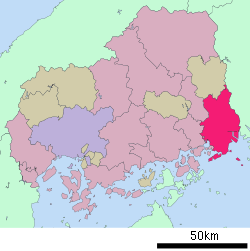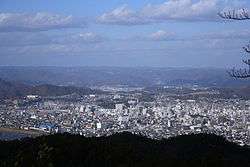Fukuyama, Hiroshima
| Fukuyama 福山市 | ||
|---|---|---|
| Core city | ||
|
View of Fukuyama | ||
| ||
 Location of Fukuyama in Hiroshima Prefecture | ||
 Fukuyama Location in Japan | ||
| Coordinates: 34°29′N 133°22′E / 34.483°N 133.367°ECoordinates: 34°29′N 133°22′E / 34.483°N 133.367°E | ||
| Country | Japan | |
| Region | Chūgoku (San'yō) | |
| Prefecture | Hiroshima Prefecture | |
| Government | ||
| • Mayor | Akira Hada (since August 2004) | |
| Area | ||
| • Total | 518.07 km2 (200.03 sq mi) | |
| Population (April 30, 2016) | ||
| • Total | 471,340 | |
| • Density | 910/km2 (2,400/sq mi) | |
| Symbols | ||
| • Flower | Rose | |
| Time zone | Japan Standard Time (UTC+9) | |
| City hall address |
3-5 Higashi-Sakura-cho, Fukuyama-shi, Hiroshima-ken 720-8501 | |
| Website |
www | |
Fukuyama (福山市 Fukuyama-shi) is a city located on the Ashida River in Hiroshima Prefecture, Japan.
As of January 31, 2010, the city has an estimated population of 465,238 and a population density of 898.02 persons per km². The total area is 461.23 km2 (178.08 sq mi).
After Hiroshima City, it is the largest city in Hiroshima Prefecture and is located on the far east side of the prefecture. The city's symbol is the rose and it holds an annual Rose Festival in the month of May. Fukuyama City is a vital commercial, industrial and communications center. It produces machinery, koto (Japanese harps), rubber products, electronics, textiles, and processed foods.
History
What is today the city of Fukuyama was founded as a castle town in 1619 by Mizuno Katsunari, a cousin of shogun Tokugawa Ieyasu. Mizuno was given command of a territory in western Japan consisting of southern Bingo Province and southwestern Bitchu Province. He built a new castle-town as his capital and called it Fukuyama.
After the abolition of the han system in 1871, Fukuyama Prefecture was founded. A short time later the prefecture was renamed Fukatsu. Fukatsu Prefecture was merged with Kurashiki Prefecture in 1872 to form Oda Prefecture. In 1875 Oda Prefecture was merged into Okayama Prefecture.
When the border between Hiroshima and Okayama prefectures was re-arranged in 1876, Fukuyama Town became a part of Hiroshima Prefecture.
Fukuyama Town became Fukuyama City on July 1, 1916. The population of the city at that time was 32,356.

On August 8, 1945 (two days after the atomic-bombing of Hiroshima), 91 American B-29 bombers made an air raid on Fukuyama, destroying much of the city.
Fukuyama was named one of the core cities of Japan on April 1, 1998.

Mergers with surrounding towns
In 1933, 10 villages from surrounding Fukayasu District were merged into Fukuyama. Two additional villages from Numakuma District were similarly merged in 1942.
On March 31, 1954, several towns and villages in Kōrimatsu District merged to found the city of Matsunaga. Matsunaga City would eventually merge with Fukuyama City on May 1, 1966.
Several towns and villages from the Fukayasu District merged into Fukuyama in 1956, and Fukayasu Town merged in 1962.
Several other surrounding towns and districts eventually merged with Fukuyama:
- April 1, 1974, Ashida Town in Ashina District
- February 1, 1975, Kamo Town, Fukayasu District and Ekiya Town, Ashina District
- February 3, 2003, Utsumi Town in Numakuma District and Shin'ichi Town in Ashina District, thereby dissolving Ashina District
- February 1, 2005 Numakuma Town, dissolving Numakuma District
- March 1, 2006 Kannabe Town in Fukayasu District, dissolving the district
Climate
Fukuyama has a humid subtropical climate (Köppen climate classification Cfa) with very warm summers and cool winters. Precipitation is significant throughout the year, but is somewhat lower in winter.
| Climate data for Tateyama, Fukuyama, Hiroshima | |||||||||||||
|---|---|---|---|---|---|---|---|---|---|---|---|---|---|
| Month | Jan | Feb | Mar | Apr | May | Jun | Jul | Aug | Sep | Oct | Nov | Dec | Year |
| Average high °C (°F) | 8.7 (47.7) |
9.2 (48.6) |
12.5 (54.5) |
18.5 (65.3) |
23.1 (73.6) |
26.3 (79.3) |
30.6 (87.1) |
32.1 (89.8) |
27.8 (82) |
22.2 (72) |
16.6 (61.9) |
11.4 (52.5) |
19.92 (67.86) |
| Daily mean °C (°F) | 3.6 (38.5) |
4.1 (39.4) |
7.2 (45) |
13.1 (55.6) |
17.7 (63.9) |
21.7 (71.1) |
26.0 (78.8) |
27.1 (80.8) |
22.9 (73.2) |
16.6 (61.9) |
11.1 (52) |
5.9 (42.6) |
14.75 (58.57) |
| Average low °C (°F) | −0.9 (30.4) |
−0.5 (31.1) |
1.9 (35.4) |
7.7 (45.9) |
12.4 (54.3) |
17.6 (63.7) |
22.3 (72.1) |
23.0 (73.4) |
18.8 (65.8) |
11.8 (53.2) |
6.1 (43) |
1.1 (34) |
10.11 (50.19) |
| Average precipitation mm (inches) | 34.6 (1.362) |
45.8 (1.803) |
69.8 (2.748) |
111.1 (4.374) |
115.0 (4.528) |
198.2 (7.803) |
170.2 (6.701) |
90.6 (3.567) |
161.9 (6.374) |
90.5 (3.563) |
55.1 (2.169) |
25.9 (1.02) |
1,168.7 (46.012) |
| Average snowfall cm (inches) | 2 (0.8) |
2 (0.8) |
1 (0.4) |
0 (0) |
0 (0) |
0 (0) |
0 (0) |
0 (0) |
0 (0) |
0 (0) |
0 (0) |
0 (0) |
5 (2) |
| Average relative humidity (%) | 69 | 69 | 67 | 68 | 71 | 75 | 77 | 74 | 76 | 73 | 73 | 72 | 72 |
| Mean monthly sunshine hours | 143.6 | 134.6 | 173.1 | 184.2 | 210.6 | 167.4 | 200.5 | 228.4 | 162.7 | 174.4 | 153.6 | 143.7 | 2,076.8 |
| Source: NOAA (1961-1990) [1] | |||||||||||||
Transportation
The city is a regional rail hub and a stop on the coastal Sanyō line as well as a terminus for the Fukuen line extending north into Hiroshima Prefecture. Additionally, three types of Shinkansen train on the Sanyō Shinkansen line (limited express Nozomi, express Hikari and local Kodama) stop there, making the city easily accessible from anywhere in Japan.
Regional and city buses carry passengers throughout the city and link it to other cities in the region. Some of the cities reachable by highway bus are Hiroshima, Kobe, Kyoto, Matsue, Okayama, Osaka, Tokyo and Yonago.

Education
Fukuyama is home to some 70 elementary schools, several dozen junior high schools and roughly twenty high schools, both public and private. Fukuyama University is located in the northwestern district of Matsunaga. The university offers many courses of study, but is best known for its excellent pharmacology program. Fukuyama City Junior College for Women is located in the Kita Honjo district.
The Holocaust Education Center in Fukuyama, inaugurated on June 17, 1995, is dedicated to the memory of 1.5 million children who perished in the Holocaust. It has the distinction of being the first institution in Japan devoted to Holocaust education.
Shopping
Fukuyama is home to several large department stores, including Lotz, Tenmaya, and Ito Yokado/Happy Town/Port Plaza. Kannabe-cho is home to the department store Fuji Grand. Many shops selling traditional Japanese goods can be found along the city's Hondori (covered shopping arcade), as well as throughout the city.
Further away from the center of town are the districts of Matsunaga, known for its traditional Japanese footwear, called geta, and Tomo-no-Ura, a fishing village known for its traditional sea bream netting display every May.
Sights
- Tomonoura - fishing port of numerous interesting temples and shrines; approximately 30 minutes south of Fukuyama by bus (14 km from Fukuyama).
- Myōōin - Buddhist temple with two national treasures.
- Taichōrō - temple hall on the hill behind the ferry terminal was built at the end of the 17th century to house a Korean delegation, which would at times pay its respects.
- Uono-sato - snack-food factory that processes most of the locally-caught fish. One can observe workers make chikuwa (ground-fish snacks) and senbei (rice crackers).
- Fukuyama Castle
- Kusado Sengen, a medieval town excavated in the Ashida River
Twin towns/Sister cities
 Kazanlak, Bulgaria
Kazanlak, Bulgaria Hamilton, Ontario, Canada[2]
Hamilton, Ontario, Canada[2] Okazaki City, Japan
Okazaki City, Japan Pohang City, South Korea
Pohang City, South Korea Tacloban City, Philippines
Tacloban City, Philippines Maui, Hawaii, United States
Maui, Hawaii, United States
References
- ↑ "Fukuyama Climate Normals 1961-1990". National Oceanic and Atmospheric Administration. Retrieved January 6, 2013.
- ↑ "Hamilton Ontario Sister Cities". Archived from the original on 2007-09-26. Retrieved 2008-01-24.
External links
| Wikimedia Commons has media related to Fukuyama, Hiroshima. |

